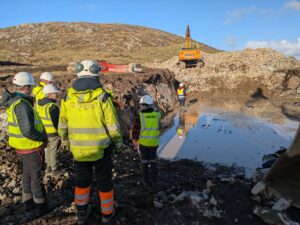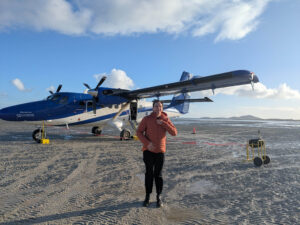There are many stories within the story of a project. Sub-stories to the main event if you will. Each one unique and interesting in its own right, adding nuanced layers to the site history. Our new Distillery project at Eoilgarry in Barra is no exception.
Last month we broke ground at the site of Barra Distillery, following years of hard work from Michael and Katie Morrison of Isle of Barra Distillers and the Project Team. This Distillery will be the first of its kind on Barra – and island with a colourful past with Scotland’s favourite dram.

The island also has a rich history and ecology which punches far above its weight, for an island with just a population of 1300 people and 60km2. The site has been in Michaels family for generations as crofting land, and is rich in Ecology, Geology and as recently discovered Archaeology. We have worked closely with our Ecologist (Atlantic Ecology) to develop a strategy for the site, and currently have an Archaeologist (Argyll Archaeology) on site undertaking a dig which is uncovering some interesting discoveries.

Another fascinating part of the story of the Barra site is the Corncrakes; a rare and elusive bird which is known to breed on Barra and across the Outer Hebrides. Crofters fields on the islands have been an invaluable habitat for the rare species due to the tall machair grass and mowing schedules for centuries. Working closely with Dr Digger Jackson of Atlantic Ecology, we carefully developed a design and construction management plan which ensures these birds can continue to thrive in the area.

Digger of Atlantic Ecology explains in his Ecological report […] “amongst many measures set out in the plan, there are two main strategies to benefit the corncrakes:

The project Archaeologist Clare, shared her teams findings during the dig on the site; […] ” The archaeology on the Barra Distillery site comprises a series of dumps of midden. Within the numerous cockle shell deposits, we have found a relatively large number of bone scoops. These have been made from split animal bone, with one or both ends worked to create a bevelled edge; the association of the scoops with cockles indicates that these were used to scoop out the flesh from the shells.

A large assemblage of pottery sherds has been recovered; the pottery is all coil-made from local clay. The other common artefact are stone tools, used for crushing, grinding, pounding and polishing. The midden is nearly 1m deep in places and covers a large area suggesting that it accumulated over many thousands of years.
The animals kept include cattle, and sheep/goat, with one whole dog skeleton found so far and fragments of others. Wild animals and birds were also exploited, with probable seal bones and bird bones found within the assemblage. The recovery of fish bones demonstrates that the inhabitants also fished, probably from land as well as from boats.
Stay tuned as work gets underway on this fascinating and beautiful site.

Image Credits: First sketch of a new geological map of Scotland by Sir Roderick Murchison – National Library of Scotland, Corncrake – Ian Lewington, A cache of bone points & Large fragment of pottery – Argyll Archaeology